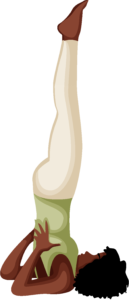Supported Shoulder Stand (Salamba Sarvangasana)
Pose Overview
| Common Name | Supported Shoulder Stand |
| Traditional Sanskrit Name | Salamba Sarvangasana |
| Sanskrit Name Pronunciation | Sah-LOM-buh sar-vahn-GAHS-uh-nuh |
| Pose Difficulty | Beginner |
| Drishti
Drishti is the gaze or visual focus point during yoga poses.
Learn more about Drishti |
Tip of the nose |
Supported Shoulder Stand, also known as Salamba Sarvangasana, is a classic yoga pose that is often used as the foundation for other inversions. It is a restorative pose that is beneficial for both the physical body and the mind. The pose is known to be therapeutic for many health conditions such as fatigue, stress, and high blood pressure. It is also said to improve digestion and circulation, as well as strengthen the shoulders, neck, and core.
Benefits of Supported Shoulder Stand
Strengthens the shoulders, neck, and core Improves digestion and circulation Therapeutic for fatigue, stress, and high blood pressure Calms the mind and promotes a sense of relaxation
How to Enter Supported Shoulder Stand
Begin by lying on your back with your knees bent and your feet flat on the floor. Place your hands on your lower back, with your fingers pointing towards your feet. Exhale as you press your hands into the floor and lift your hips towards the ceiling. Slowly lower your head and shoulders to the floor, supporting your weight with your hands. Straighten your arms and press your elbows and forearms into the floor. Keep your neck in a neutral position and breathe deeply.
How to Exit Supported Shoulder Stand
Slowly lower your head and shoulders to the floor. Lower your hips to the floor as you exhale. Rest in Child's pose or Corpse pose.
Common Supported Shoulder Stand Modifications & Variations
If you have difficulty lifting your hips, you can use a block or a blanket for support. For an advanced variation, you can lift one leg at a time, or even both legs together.
Common Mistakes with Supported Shoulder Stand
Arching the lower back Rounding the shoulders Overstraining the neck
Safety Guidance
Avoid this pose if you have neck or shoulder injuries Avoid this pose if you have high blood pressure, or if you are menstruating Keep your neck in a neutral position to avoid straining it

